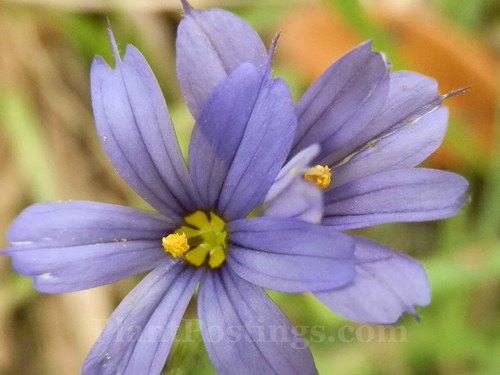
Imagine stepping out of your car in a large parking lot and seeing delicate, periwinkle blue, tiny blooms in all directions.
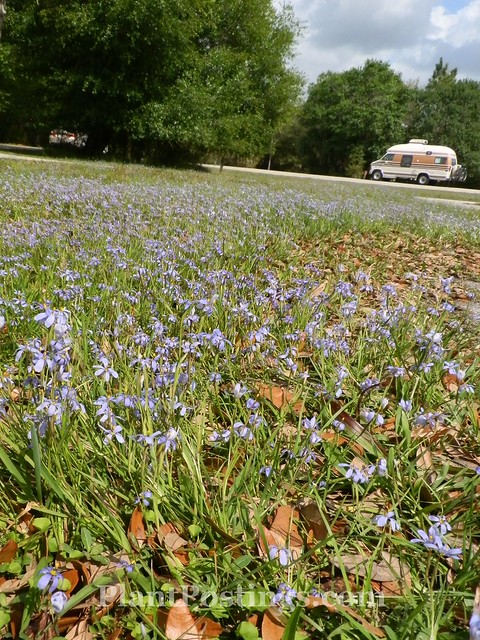
That's what happened to us during a visit to a Florida state park in early March.
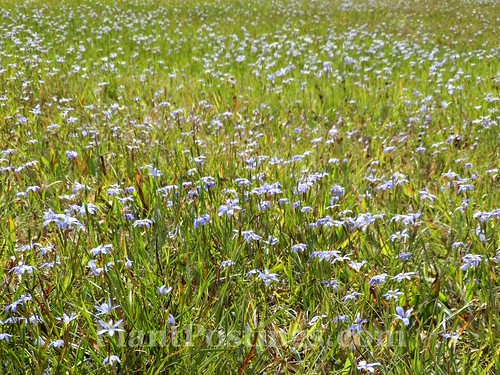
The blooms we saw were those of Blue-Eyed Grass and, although I don't know for sure, I'm assuming they were the more common North American species (Sisyrinchium angustifolium).
Besides the fact that they were incredibly lovely and plentiful in this naturalized setting in Florida, I knew they also bloom in my northern state, albeit much later in the season ... like now, in May and June.
In fact, according to the Lady Bird Johnson Wildflower Center, this species is native to most of Eastern North America--from Newfoundland, west to Ontario, in the north; through Florida and Texas, in the south. In other words, it thrives in USDA zones 3 to 10.
I also found a patch within my parents' Florida retirement community. The landscaping folks mow it once a week, and it pops right back up to bloom again! Floridata, the Floridata Plant Encyclopedia mentions that, "Blue-Eyed Grass is a great little plant for almost anywhere in the garden. It needs almost no attention, thriving with neglect."
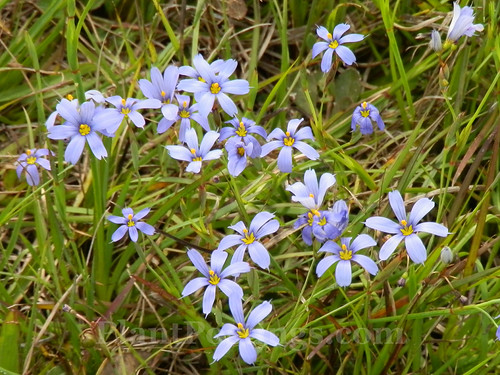
Although its nickname includes the word "grass," this plant is a member of the same family and subfamily (Iridoideae) as Irises. It only grows to 1.5 feet, and forms tufted clumps. It can be propagated by seed or division. And it prefers moist conditions, although it can tolerate poor to average soils.
I was familiar with Blue-Eyed Grass, having seen it growing wild in Wisconsin in prairie settings. But I had never seen it naturalize in such a wide expanse before. In addition, I hadn't planted it in my own garden, because I figured it needed more sun. Recently, I was delighted to find out that not only can Blue-Eyed grass tolerate some shade, "especially high shade, as under tall trees," notes Floridata, it also takes well to potting. So, Blue-Eyed Grass will soon make an appearance in my "high shade" garden.
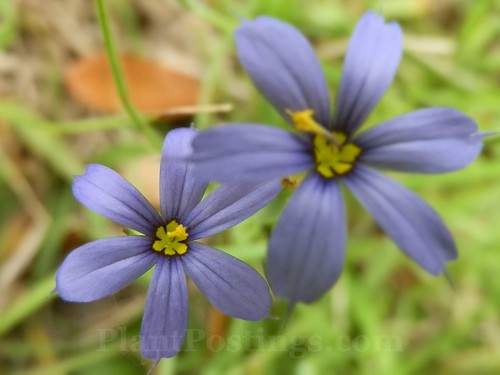
I'm linking this post to Gail's Wildflower Wednesday meme, over at Clay and Limestone. Head on over to learn about fascinating wildflowers from around the world.
Update for Wisconsin readers: Sisyrinchium angustifolium is a State Special Concern Plant in Wisconsin. Click the link to learn more about what that means. Propagate by purchasing plants or seeds from a reliable native plant garden center.
It is a great little plant, I agree! I had no idea it was so tough.
ReplyDeleteI was so surprised to see it blooming en masse like that--covering large fields with blue blooms. I really did a double-take. I think my family thought I was crazy for wanted to take photos of "grass" next to the parking lot, but I couldn't believe so much Blue-Eyed grass was blooming there. It was lovely.
DeleteSuch a pretty sight and beautiful native plant, Beth.
ReplyDeleteI agree, Donna. I think it's beautiful in small tufts, too. It is the kind of plant that one can appreciate from afar--in large drifts--and close up--in small patches.
DeleteThere is a lot of them growing around the house but they are not so thick as in your pictures. There are lots of them but they grow among taller things and you have to bend down to see them. It is just amazing to be able to grow from zone 3 to 10!
ReplyDeleteI know--these plants that thrive in such diverse climates and conditions amaze me! In the past, I'd only seen Blue-Eyed Grass hiding in the middle of a prairie, which was a sweet experience. But large swathes of it, like we saw in Florida, were beautiful, too.
DeleteBeautiful
ReplyDeleteIt is a pretty plant, isn't it? I really like the colors. The yellow compliments the blue.
DeleteBeth, I love this grass but I think it was swallowed by weeds...I hope to see it up and about the garden again...what a sight to see this growing in such a large expanse...it would look great instead of a lawn.
ReplyDeleteYes, I think it would be a nice replacement for some areas of the lawn, anyway. I definitely want to add Blue-Eyed Grass, but I'm trying to figure out the best place for it. :)
DeleteDear Beth, considering the broad range of conditions where Blue-Eyed Grass is able to grow I should have seen it here in America already, but I didn't so far. Maybe I just have overlooked it? I wonder if it does grow in Southern California, too.
ReplyDeleteAnyway, I learned something new in your post (again!) and I would like to thank you for that.
The carpet of Blue-Eyed Grass that you photographed in Florida looks absolutely stunning!
Warm regards,
Christina
Hi Christina: You're welcome! And thank you! Apparently, there are about 200 species of Sisyrinchium, and some are native to California. Here's one: http://www.calflora.org/cgi-bin/species_query.cgi?where-taxon=Sisyrinchium+bellum. I was shocked by the expanse of it. Wasn't sure it was Blue-Eyed Grass until I looked closer. :)
DeleteThis is amazing! We have this Sisyrinchium as a perennial plant in our country but it often does not survive our wet winters. So nice to see in the wild as 'blue eyed grass'.
ReplyDeleteInteresting! So, I guess it prefers moist, but well-drained soil? It is fun to find it in the wild, and en masse in a big field. I think I might plant some in a pot.
DeleteBeautiful color. Love the color... Enjoyed seeing them...
ReplyDeleteI love the color, too. I've always enjoyed periwinkle/cornflower/
DeleteFrench blue. That range of blue is so pleasing to the eye, and calming in some way.
Blue-Eyed Grass is great and I wish I had more of it. I find it growing in our marsh in Wisconsin, but it is few and far between. I remember hearing there is a sizable patch somewhere south of Montello off Highway 22 somewhere, but do not know the exact location.
ReplyDeleteHmmmm ... I'll have to hunt for it, Nick, on our next trip up there. I don't remember seeing it and we take that route frequently. Of course, we're usually driving quickly along the highway. Lucky you, to have some growing on your property!
DeleteWhat a beautiful flower and excellent photographs.
ReplyDeleteThank you, Tim! Yes, it's an attractive plant--especially when it's blooming.
DeleteI've tried to grow it here at Our Little Acre, but it dies every time. :-( It's native for us too, in fact, I've seen it just down the road, back a little lane at the edge of the woods, where it does just fine. I guess I'll have to admire it there!
ReplyDeleteThat always fascinates me--how a plant can thrive in one spot, and struggle in another one even if it's nearby. I guess that's the function of microclimates. Isn't it fascinating, Kylee, to discover little microclimates around your garden? I've never tried growing Blue-Eyed Grass, so I don't know if it will work here either. I hope so!
DeleteSo pretty! I'm pretty sure this is what I saw when I visited my daughter in Texas in mid-April--thanks for identifying it! I wished at the time I had a Texas wildflower book, as I saw a lot of wildflowers I was unfamiliar with.
ReplyDeleteApril seems like a great time to visit Texas, Rose! I hope to make a trip there some April. We vacationed in San Antonio and drove to other parts of Texas in March one year, and it was great then, too. I'm glad you had a great time visiting your daughter. :)
DeleteI had one little clump of Blue-eyed Grass grow between some limestone on my back patio this spring and no idea where it came from. But a whole field of it? Shazaam! And Wow! Beautiful photos, as usual and thanks for the look-see of Blue-eyed in mass!
ReplyDeleteThank you. :) Don't you love those volunteers that show up in the garden on their own (with the help of critters)? I enjoy this plant in little clumps and en masse. Such a pretty little flower, and the color is gorgeous.
DeleteVery pretty!
ReplyDeleteHave a great day!
Thanks, Lea! Enjoy your day, too. :)
DeleteGreat pick, Beth!
ReplyDeleteI added some to the garden this spring and so far (knock on dry wall) it seems to be doing great. It's been blooming for about two months - although I've noticed the flowers stay closed on cloudy days - and looking pretty and perky.
I knew the plant was tough (I've heard it can thrive on roadway medians), but like Hollis said, I didn't know it was tough enough to survive weekly mowings. Wow.
As Donna wrote, I wonder if this could be a component of a lawn substitute??
Ha! I'm glad to hear it's working well for you Aaron! Blooming for two months--wow! A pretty little native flower that blooms that long is a must-have! I could see substituting some areas of the lawn with Blue-Eyed Grass. I would think that might be a great option for other state and national parks in areas adjacent to parking lots.
DeleteI've always been very fond of that expression: thriving with neglect!
ReplyDeleteYes, me, too! Apparently, it's a State Special Concern plant here in Wisconsin. Probably because we've plowed up so many of the prairies for farms and developments. It's encouraging that people are realizing how rare and special prairies are. Sad that a plant that thrives with neglect can be a "special concern" plant here.
DeleteIt is so pretty growing en masse like that. Sisyrinchium can be quite invasive but it doesn't matter if you grow it in grass. Lovely idea.
ReplyDeleteI do like the idea of growing it amongst the grass. I also like the idea of growing it along a border or in a pot. :)
Deleteexquisite little beauty!
ReplyDeleteYes, it's lovely. :) I hope more people will plant it.
DeleteLovely plant. What a nice way to add more blue to the garden.
ReplyDeleteThe shade of blue is so gorgeous, too. Can't wait to add some to my garden.
DeleteIt's almost a pest here, but a very pretty pest.
ReplyDeleteIt's hard for me to imagine it being a pest, except that when it's not flowering it looks like grass. But I understand what you mean. My Drumstick Alliums are the same way. Because they look like grass until they flower, it's hard to weed around them.
DeleteI'm impressed with the thick growth of the blue-eyed grass, it makes me want to grow some, but I'm not sure it can handle our rainless summers. Perhaps it would grow near the hose bib here, in the grass. I have lawn daisies so they would be cute together.
ReplyDeleteHi Hannah: That sounds like a great spot for this plant. Yes, I'm imagining the Daisies and Blue-Eyed Grass blooming together. That would be lovely!
DeleteHi,
ReplyDeleteMy parents have the blue-eyed grass growing along the river bank along the Elk River in Northern Wisconsin. We just love sitting and fishing along side its beauty.
Carla: What a beautiful scene you've painted in my mind. :) Blue-Eyed Grass, fishing, a river in N. Wisconsin ... sounds like a perfect day!
DeleteI love these little flowers! And knowing that they bloom in Florida assures me they would do great in a garden here. They get into my list for future gardening. Thanks!
ReplyDeleteHi Lula: Apparently there are about 200 species of Sisyrinchium, and some are grown as annuals. They might be a good option as potted plants for you. I don't know if they're considered invasive outside North America.
DeleteI can imagine how it would look naturalized in a large area. Lovely.
ReplyDeleteYes, the fields of Blue-Eyed Grass had me swooning. I've never seen it like that before. Always little patches here and there within a prairie. But it seems like a good option within the grass at a state park. I would think it would compete with non-native weeds in a lawn?
DeleteI have heard of blue eyed grass but have never seen it growing wild or in a garden. It is a lovely plant, if only I had more space!
ReplyDeleteIt's a bewitching little plant with sweet blooms. I'm so glad to hear it can tolerate a little shade--I had no idea.
DeleteIt's such a beautiful blue, and so perky...I just wish it bloomed for longer here. When they bloomed on the nursery shelf they flew out the door each time.
ReplyDeleteTo see a field of them like your image...what a treat!
Jen
Hi Jen: Yes, seeing the fields full of blue was a sweet treat! I think it only blooms for about a month here, too. Sounds like the blooms last longer in Florida.
DeleteBeautiful little flowers I love seeing field of flowers. Gorgeous sight. Happy Friday, have a great weekend!
ReplyDeleteHi Eileen: I so enjoy unexpected surprises like this! I think my family was underimpressed, but it made my day. ;-) Happy Friday to you, too!
DeleteThey're so pretty, and one of the first prairie plants to come up in the spring, but so fleeting here. It must have been amazing to see them in such a wide expanse.
ReplyDeleteYes, it was wonderful, Heather. I could have spent hours photographing them. True gems, in my book.
DeleteWhat a lovely site....a field of blue-eyed grass! Because it's so hardy I'm surprised I haven't seen it more often! Come next spring, I hope you have a slew of little blue-eyes smiling up at you! Happy Gardening!
ReplyDeleteThanks! I'm debating when and where to add them to the garden. All I know is I'm glad they can tolerate shade, and I want to add them. The fields of Blue-Eyed Grass were amazing!
DeleteI have found Blue-Eyed Grass in my own garden here and there, and I have always thought it is beautiful. I have never seen such a stand as you show in your first photo; that is fabulous! It makes me want to transplant my isolated ones to a place where they can grow together and make a visual impact.
ReplyDeleteHi Deb: Lucky you! I'm thinking I might start out with pots and see how they do. Then maybe I'll add more. I imagine they must bloom longer in your warmer climate.
DeleteI have this little guy in my rain garden. I amended the holes with pea gravel so it could drain well. I also have a cultivar with tan flowers called 'Quaint and Queer'. Very easy plant to grow. I'd love to see a field of them!
ReplyDeleteSounds perfect, Tammy! I did the same thing with some Whorled Milkweed I transplanted, since it seems to prefer well-drained soil, too. What an interesting cultivar! I wasn't familiar with that one.
DeleteWhat a treat to see that big expanse of blue eyed grass! I may have planted one before, but it didn't survive. I hope you have found some to plant.
ReplyDeleteThanks for your nice comment on my Wildflower Wednesday post. I do enjoy being a grandma, and hope our granddaughter continues to enjoy looking at the flowers and watching for insects. I also hope the boys renew the interest they used to have in being in the garden. Yes, amsonias look good all season, especially the hubrichtii.
Hi Sue: Yes it was great! I'm still debating when and where to plant them--maybe in the fall, in pots. We'll see. Everything I hear about Amsonia hubrichtii makes me want it. Even if it isn't native here, it's native nearby and tolerates my zone. I love the fact that it provides exceptional garden interest in three seasons.
Delete